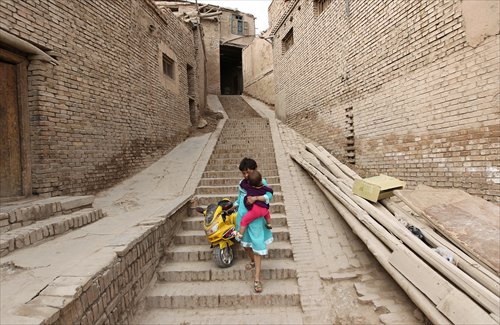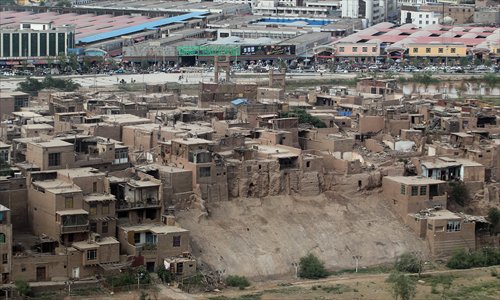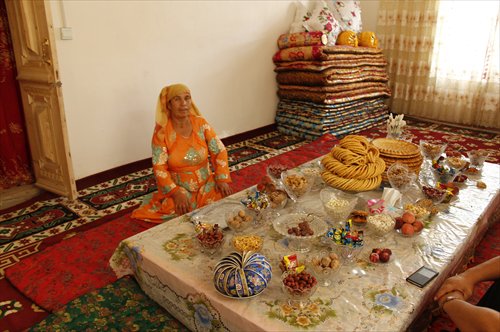Old Kashgar homes cautiously renovated to stay true to Uyghur culture

Uyghur children descend from a slope of stairs in the Gaotai residential area in central Kashgar, Xinjiang Uyghur Autonomous Region. Photo: Cui Meng/GT
Zola Guri, 39, has been living in a 20-square-meter mud house since she was born. She inherited the 150-year-old house from her ancestors and vowed to preserve this historical treasure and pass it down to her offspring.
But now, Guri wants change.
"The house needs a complete renovation, from inside to outside," Guri, a Uyghur mother of three, told the Global Times, in her 10-square-meter living room which is half-occupied by a large sleeping platform.
"It's too crowded for me, my husband, and three children to live in. The living conditions are awful. What's more, the house is dilapidated and it is dangerous for us to live inside it."
Guri's home is one of the 447 households in Gaotai residential area, which, with 600 years of history, still maintains the traditional lifestyle of the local residents. However, the fragile structures are now in urgent need of reinforcement.
A majority of the households in the area have the same problems as Guri does.
Built on a loess plateau in the southeast section of the old town in Kashgar, houses in the Gaotai residential area are old and dilapidated. They want their centuries-old houses to be renovated, but lack the money and capability to improve their living conditions.
People like Guri hope an ongoing renovation project in the old town, aimed at preserving the cultural relics while enhancing their ability to resist earthquakes, will benefit them.
Local authorities have made great efforts to renovate and enhance their earthquake resistance capability since 2009. The renovation work, encompassing 28 dilapidated districts, 65,000 households and 5.07 million square meters, aims to be completed by 2017, statistics from local authorities showed.
However, as the renovations progressed to fixing other outlying parts of the old town, the renovation work of Gaotai, the core center of the old city, never really started.
Local authorities have placed some basic frame "skeletons" to support the weight of dilapidated outer walls on several houses there, but aside from that there has been no significant renovation. Some families have left the area and moved to other places due to the bad living conditions and safety hazards.
"We have to deal with it cautiously. There are critics who say that we might destroy or cause damage to the relic houses if the work cannot be done properly," He Tao, a member of the standing committee of the Communist Party of China's Kashgar committee, who is in charge of the renovation of the old town, told the Global Times.
"In this way, we have to be thoughtful about the protection and renovation plan before we start to work."

An overview of the Gaotai residential area in Kashgar. Photo: Cui Meng/GT
Thorny problems
Finding ways to maintain the old appearance of the dilapidated centuries-old Gaotai houses, while reinforcing them to ensure people's safety, has become a thorny problem.
Mud houses in Gaotai are diverse, with a variety of internal structures. "Each house has distinctive architectural forms, and the structures are all different. We have to make the renovation plans on a case by case basis," He told the Global Times.
There are 447 households in Gaotai. Most of the houses used the traditional wood-and-earth, and brick-and-wood construction.
The unstable structure and unique style of the construction have made it difficult to find the right people to do the renovation work.
"You have to restore the inside and outside of these houses in the old style. It is very difficult to find a team to do so," He said.
Over the past four years, Kashgar authorities have invited conservation agencies and architecture and design companies to build sample houses that could both replicate the original ancient style and improve their earthquake resistance with the fusion of modern structural techniques, but none were satisfactory.
"We asked them to replicate the mud outer wall using the traditional method of construction. But now, you see, the new outer wall has no essence of the original ancient style at all," Shi Shixiong, director of the office of dilapidated housing rehabilitation in Kashgar, told the Global Times, pointing to the sample house with outer walls made of rammed mud and wheat-straw.
In one alley, several sample houses scattered among the old houses stand apart due to the new colors of their outer walls, sharp edges and corners and stiffness.
"It is easy to build houses, but difficult to replicate the imprint of age," Shi said.
In August last year, Kashgar authorities issued a tendering notice on China Construction News, inviting design companies and conservation agencies who are capable of maintaining their original appearance and fortifying their structures to renovate the Gaotai residences.
Weeks went by, and none submitted tenders.
"Protecting and renovating Gaotai could be tough. People would be quickly criticized if the work was not done properly. That explains why there has been no response," He told the Global Times.
After a lot of research, the authorities discovered that an architecture research institute under Southwest Jiaotong University, which is reputable for its professionalism of heritage conservation and its earthquake resistance capabilities, might be capable of doing the job.
Months ago, local officials visited the research institute and invited them to participate.
A plan for the renovations has been completed and is to be submitted to the upper-levels of the Xinjiang authorities for approval.
"If the plan is approved, the renovation work on Gaotai residential areas will really begin," He said.
But for now, Guri has to wait to see if she will live in a safer house in the foreseeable future.

Adili's wife in their renovated house in the old town of Kashgar near the Gaotai area Photo: Liang Chen/GT
Criticism and doubts
Previously, when the local authorities firstly announced their renovation plans and launched a pilot project in Kashgar in 2009, some people misrepresented the government's intentions and said it was destroying the cultural heritage of the Uyghur people and forcing them to leave their ancestral land, He said, making it difficult for the local authorities to push forward the project.
Plus, due to a lack of publicity of the necessity and importance of the renovation work, local Uyghur people had little or no understanding of the governments' intentions. The project was halted.
In June 2009, a delegation group from the United Nations Educational, Scientific and Cultural Organization (UNESCO) visited the old city of Kashgar and offered a positive evaluation on the government's renovation work, saying "there are some aspects of the renovation of the old city worthy of promotion, such as the designation of the pilot area, encouraging residents to participate, and certain methods of building reinforcement."
Evaluations from UNESCO and consistent publicity work from local officials dispelled people's doubts.
In August 2010, eight departments and ministers, including the National Development and Reform Commission, the Ministry of Housing and Urban-Rural Development and the State Administration of Cultural Heritage, approved the renovation plan involving dilapidated houses in 28 districts, with Gaotai as one of them.
The total investment was around 7.05 billion yuan ($1.15 billion): 2 billion allocated by the central government in Beijing, 1 billion from the Xinjiang authorities and 226 million from the affordable housing construction subsidies.
Local residents need to provide the remaining 2.39 billion yuan.
More problems quickly arose. "Some villagers who were unwilling to pay the money came to us, saying they didn't want their houses renovated unless the authorities paid all the costs," He told the Global Times.
In order to encourage people to renovate, He said, he and his colleagues had to travel back and forth between the construction sites and the government buildings at least three times a day, dropping in on the residents to publicize the compensation policies and renovation regulations.
Local authorities encouraged local residents to dismantle and renovate their houses according to their own requirements.
"We don't adopt a 'one size fits all' style. We offer them money, compensation and construction teams. Each household can get compensation of 580 yuan per square meter, which can cover the basic renovation fee," He told the Global Times.
"They can choose their own designs and make any modifications until they are satisfied," He said.
To encourage people, local officials carried wads of compensation money to the homes of the Uyghur people after they started the renovation work.
"Residents were rallied to participate in the renovation work by themselves. They supported each other by helping others with the construction work," He said.
In a booklet that shows the appearance of the blocks before and after the renovation, an old man with white beard was shoveling while a young boy was carrying bricks.
"All the family members participated in the renovation, which is beneficial for the harmony of society," He said.
Now, walking in the outlying regions of the old town, you could mistake yourself as wandering in a picturesque city in the Middle East. Rows of two-storey houses, decorated by reliefs, statues and flowers and painted with different colors, are lined up alongside the road. The road is wider with a broad pavement.
Adili Mamat, 60, has lived in the region for decades. He was among the first batch of residents who agreed to renovate his dilapidated house. He started renovation in April 2013 and moved into the new house in October.
Adili has always dreamed of living in a new, beautiful house, though he had always lacked the money to do so.
After the renovation plan was publicized by local officials, Adili decided that he would sell his father-in-law's mud house in the downtown area at a price of 250,000 yuan, for the construction of the new house.
Now, the two-storey house with seven rooms, which cost him 870,000 yuan in total, can accommodate six family members.
To pay a loan of 70,000 yuan, Adili opened a grocery store and rented out three rooms on the first floor, from which he can earn nearly 40,000 yuan per year.
"Even though I have to pay the debts, I don't regret spending money on the renovation of the house. Nothing is more important than living in such a beautiful house," Adili told the Global Time, in his living room where the two-meter long tea table was covered with dishes of jujubes, a Xinjiang traditional food, and fruits.
Newspaper headline: Formidable revival